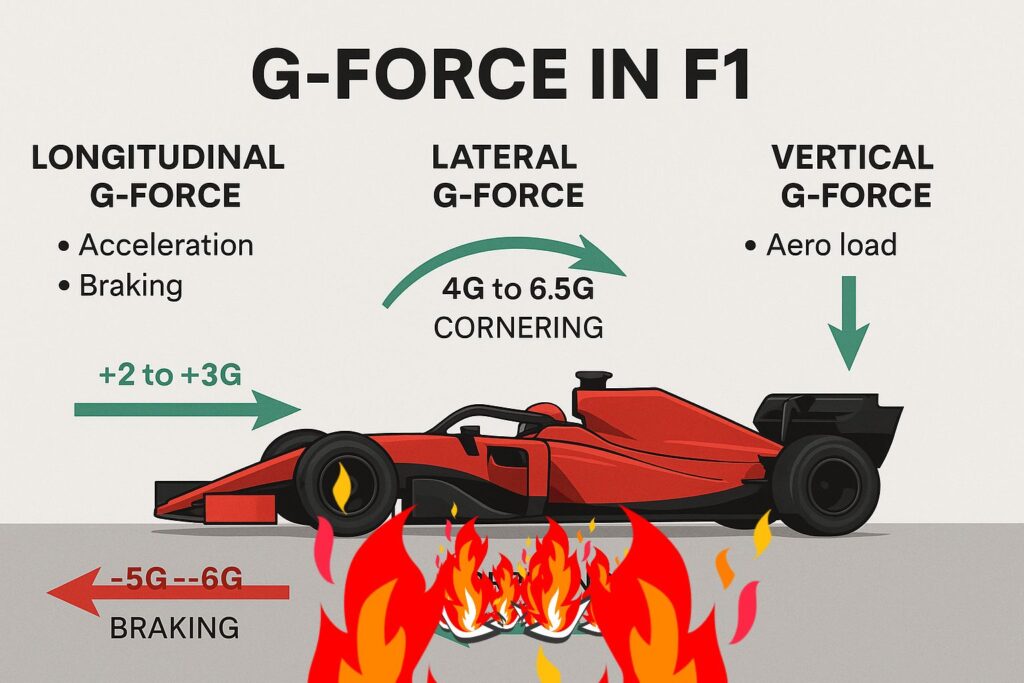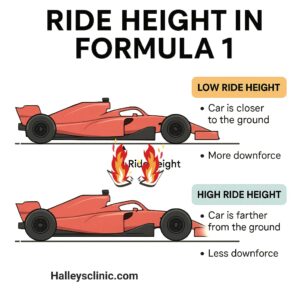What Is G-force and Why Is It Important in F1?

- By Dr. AK Rana
All F1 fans have heard this term ‘G-force’ a lot of times, some knows about it, others have just kind of idea.
But what exactly it is? And why drivers mention it frequently, especially when they train their neck!
…
G-force (short for gravitational force) is a measure of acceleration relative to the acceleration due to gravity on Earth.
1G = 9.81 m/s², which is the force you feel due to Earth’s gravity when standing still.
…
If you’re experiencing 2G, you’re feeling twice your body weight pushing on you.
In simple terms:
G-force is how much extra weight your body feels due to acceleration, deceleration, or direction change.
—
🏎️ In Formula 1:
F1 cars are extremely fast, and they:
Accelerate like a missile,
Brake harder than almost anything on wheels,
Corner like they’re glued to the track.
This leads to massive G-forces in three main directions:
—
1. Longitudinal G-force (Forward/Backward)
Occurs during acceleration and braking.
…
F1 drivers experience:
+2 to +3G under hard acceleration
-5G to -6G under heavy braking
(That’s 5-6 times their body weight thrown forward into the belts)
—
2. Lateral G-force (Side to Side)
Happens during cornering.
…
In high-speed corners, G-forces can reach:
4 to 6.5G laterally
(Body is pushed sideways with 6x its weight — try turning your head at that point!)
—
3. Vertical G-force (Up/Down)
Comes from kerbs, bumps, or vertical load due to aero downforce.
F1 cars can produce downforce equal to twice their own weight — pressing the driver into the seat with several Gs vertically at high speed.
—
What G-force Feels Like for an F1 Driver
Imagine this:
…
Weigh 70 kg? Under 5G in a corner, it feels like 350 kg is pulling you sideways.
The helmet alone can feel like it weighs 30+ kg on your neck mid-corner.
…
Braking from 300 km/h to 80 km/h in 2 seconds generates 5-6G — you feel your organs shift inside your chest.
That’s why F1 drivers train neck, core, and reaction speed extensively — not just for driving skill, but to survive this level of physical punishment.
—
G-force in F1 is the invisible hammer pounding drivers every second — forward, backward, sideways, and down.
That’s why F1 drivers are elite athletes, not just skilled drivers.
…
G-Force in a Crash: What Happens?
…
In a crash, a Formula 1 car often goes from very high speed (e.g., 300 km/h) to zero (or close) in a fraction of a second.
That creates massive deceleration, and thus extremely high G-forces — sometimes over 50G or even 70G.
—
Formula:
G-force in a crash =
Rate of deceleration ÷ 9.81 m/s² (gravity)
So, if the car slows at 500 m/s², the G-force is
500 / 9.81 ≈ 51G
…
50G = 50 times your body weight.
So a 70 kg driver feels like they weigh 3500 kg for a split second.
The forces compress the body, slam organs against bones, and put immense strain on the brain, neck, spine, ribs, and seatbelts.
It’s not survivable without advanced safety systems.
Real F1 Crash G-Force-
Max Verstappen (Silverstone) – 2021, 51G Wall impact at Copse — bruised, conscious
Fernando Alonso (Australia) – 2016, ~46G Flipped car, total wreck — walked away
F1 isn’t just fast — it’s a masterclass in surviving speed.
Drop your thoughts in the comments
Stay tuned with Halleysclinic.com
📧 Contact: halleysclinic@gmail.com
Don’t forget to follow our Instagram account https://www.instagram.com/halleysclinic






1 thought on “What Is G-force and Why Is It Important in F1?”